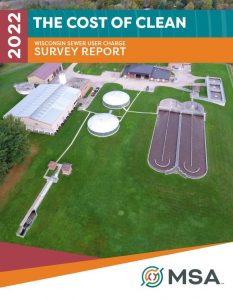What citizens pay for sanitary sewer service varies significantly from community to community. We know because we’ve been studying the data for 25 years.
But, should there be a baseline, or at least some guidance toward setting a rate that is both sustainable for residents and the environment? We think so. Because the true cost of providing safe, clean water is often undervalued. And as the availability of our clean water continues to shrink, we are obligated as municipal leaders and water professionals to evolve our practices — and perhaps adjust our rates — to reflect water’s true worth.

This year, MSA embarked upon our 10th Wisconsin Sewer User Charge Survey. We invited over 700 Wisconsin Pollutant Discharge Elimination System (WPDES) permit holders to help us by answering a few questions about their community, sewer rates and wastewater treatment system. The goal was to collect, analyze and publish a free report about our findings, which reflects the current costs of sanitary sewer service across the state of Wisconsin.
The 2022 Wisconsin Sewer User Charge Survey Report provides municipal leaders and utility departments with a candid, comparative analysis of sewer rates. This information is irreplaceable when applying for funding or when making decisions about rate increases and infrastructure upgrades. After all, facility upgrades are costly, and sewer rates can be used to make incremental steps toward improvements. The report is also helpful when introducing rate increases to the public and offers real data to support or justify decisions made.
Why does MSA care?
MSA CEO Gil Hantzsch, PE, has a deep-seated interest in clean water and wastewater treatment initiatives. This passion led him to pioneer the first Wisconsin Sewer User Charge Survey for our firm in 1996. We’ve been dedicated to conducting the survey every three years since. “The most telling finding in those early years of the survey was the unbalanced economy of scale,” recalls Hantzsch. “The costs associated with constructing a gallon per day of treatment capacity was much higher for smaller communities. This data has allowed us to advocate for funding to be applied to the populations bearing the highest per-user cost, which tend to be small municipalities. It has also helped communities understand the ever-increasing cost of providing clean water, and how being proactive early can reduce their rates in the long run.”
Clean water is integral to the health and safety of our communities. We all have a role in helping to protect the integrity of our water sources, particularly those who make decisions about the design, implementation, operation, maintenance and funding of municipal water and wastewater treatment systems. Whether a small rural community or a large metropolitan area, we believe the data gathered and compiled through our “Cost of Clean” survey makes a difference in helping leaders balance environmental responsibility with local affordability.
Together, we can support the health of Wisconsin water and the financial health of Wisconsin communities.
For more information, email ratesurvey@msa-ps.com.
